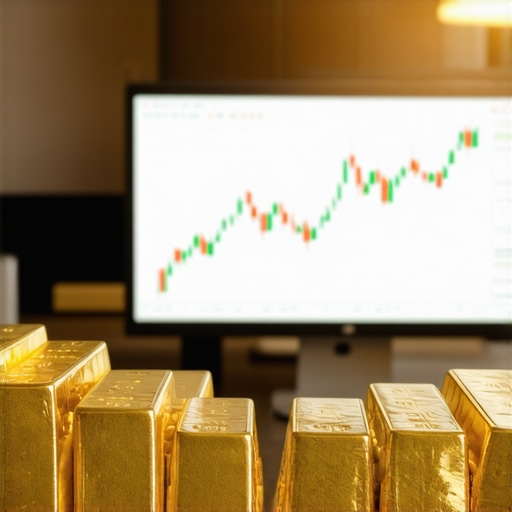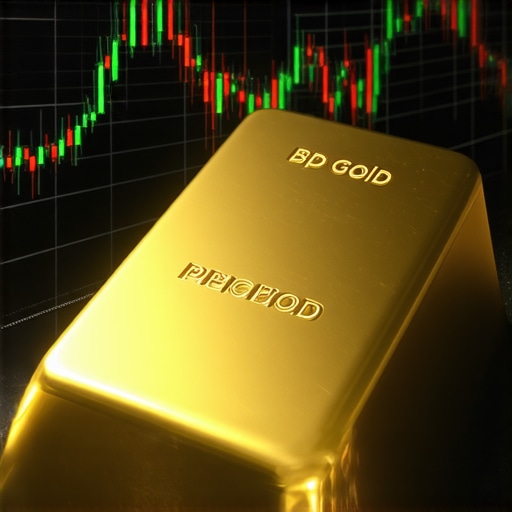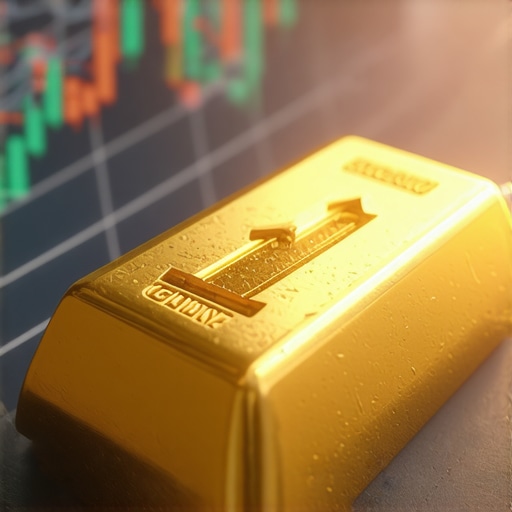Peering into the Golden Horizon: Why Long-Term Gold Price Forecasts Matter
Gold has always captivated investors as a timeless store of value, but predicting its price trajectory over the next five years demands a nuanced understanding beyond mere speculation. As global economic uncertainties, inflationary pressures, and geopolitical tensions shape financial markets, gold’s role as a safe haven asset becomes increasingly complex yet essential to decode. This article dives deep into the long-term outlook for gold prices, unraveling the interplay of demand dynamics, central bank policies, and market sentiment that will govern its path ahead.
Unveiling the Forces Driving Gold’s Future Value
The gold market is influenced by a constellation of factors that collectively mold its price trends. Central banks’ aggressive gold purchases, especially by emerging economies, have become a pivotal element, tightening supply and underpinning demand. According to the World Gold Council, central bank acquisitions surged to notable highs in recent years, signaling a strategic pivot away from traditional fiat currencies (World Gold Council Report, Q4 2023). Furthermore, inflationary pressures worldwide continue to enhance gold’s appeal as a hedge against currency debasement, with investors seeking refuge amid volatile equity markets and fluctuating interest rates.
Innovative Investment Vehicles: Gold ETFs and Mutual Funds Shaping Long-Term Gains
Beyond physical gold, investment trends increasingly favor gold ETFs and mutual funds, which offer diversified exposure with liquidity advantages. These vehicles democratize access to gold market gains while mitigating risks associated with direct bullion ownership. For those evaluating portfolio diversification, exploring gold ETFs and mutual funds is an insightful step to grasp the evolving landscape and optimize returns.
How Will Global Economic Shifts Impact Gold Prices Over the Next 5 Years?
Global economic trajectories, including the interplay between inflation trends, interest rate policies, and geopolitical developments, will significantly influence gold prices. For instance, prolonged inflationary periods typically buoy gold as a non-yielding asset that preserves purchasing power. Conversely, rising real interest rates might temper gold’s allure by increasing opportunity costs. Additionally, geopolitical tensions—such as trade disputes or regional conflicts—often trigger spikes in gold demand as investors seek stability. Monitoring these multidimensional economic signals is vital for informed long-term investment strategies.
Case Study: Central Banks’ Strategic Accumulation and Market Implications
Consider the practical example of central banks in Asia and the Middle East intensifying gold purchases since 2020. This strategic accumulation not only reduces available supply but also signals confidence in gold’s enduring value. Their moves often set off ripple effects across global markets, influencing investor behavior and price momentum. Understanding these patterns helps investors anticipate potential market shifts and align their portfolios accordingly. For an in-depth analysis of this phenomenon, see how central bank gold purchases influence prices.
Embracing Gold’s Multifaceted Role in Portfolio Strategy
Long-term investors increasingly recognize gold’s unique ability to act as a hedge, a diversifier, and a store of value. Integrating gold thoughtfully into portfolios requires balancing physical holdings, ETFs, and even gold mining stocks to capitalize on different aspects of potential growth and protection. For those interested in gold stocks with promising prospects, resources like best gold stocks to watch for profitable gains provide valuable guidance on navigating this segment.
As you explore the intricate world of gold investments, consider sharing your thoughts or questions below to foster a community of informed, strategic investors.
Decoding Gold Price Volatility: Navigating Market Fluctuations with Precision
While gold is often hailed for its stability, investors must acknowledge its inherent price volatility influenced by short-term market dynamics. Factors such as currency strength fluctuations, speculative trading, and changing interest rate expectations can trigger rapid price swings. For example, the U.S. dollar’s inverse correlation with gold prices means that dollar appreciation can temporarily suppress gold’s value, despite a bullish long-term outlook. Therefore, understanding these transient forces is crucial for timing entry and exit points effectively.
Advanced investors often employ technical analysis tools alongside fundamental insights to decipher gold’s price movements. Indicators like moving averages, Relative Strength Index (RSI), and Fibonacci retracement levels can reveal momentum shifts and potential support or resistance zones. Integrating these analytical approaches with macroeconomic assessments enables a more sophisticated strategy, minimizing emotional decision-making during market turbulence.
Integrating Gold Mining Stocks: Balancing Growth Potential and Risk Management
Gold mining stocks offer an alternative pathway to benefit from gold price appreciation while introducing unique risk-return profiles. Unlike physical gold or ETFs, mining equities are subject to operational risks, geopolitical factors, and company-specific management efficiency. However, they often provide leveraged exposure to gold prices, magnifying gains when prices rise.
For investors seeking growth alongside diversification, selecting high-quality mining stocks requires rigorous due diligence. Factors such as proven reserves, cost of production, geopolitical stability of mining locations, and dividend policies become critical evaluation criteria. Resources like gold mining stocks to watch for growth in 2025 provide curated insights into companies poised for potential expansion.
What Are the Key Indicators Experts Use to Forecast Gold Price Trends Amid Global Economic Uncertainty?
Expert analysis on gold price forecasts leverages a blend of economic indicators, geopolitical developments, and market sentiment gauges. Inflation rates and central bank interest rate decisions remain foundational, as they directly affect gold’s opportunity cost. Additionally, tracking central bank gold reserves offers clues on institutional confidence in gold, while geopolitical tensions often serve as catalysts for sudden demand spikes.
Moreover, investor positioning data, such as futures market open interest and ETF holdings, provide real-time sentiment snapshots. The World Gold Council emphasizes the importance of these indicators in their comprehensive research, underscoring the multifaceted approach required for accurate forecasting (World Gold Council Report, Q4 2023).
Leveraging Gold ETFs for Dynamic Portfolio Exposure
Gold ETFs continue to evolve as sophisticated instruments, offering both short-term liquidity and long-term exposure. Unlike direct physical gold holdings, ETFs enable investors to swiftly adjust allocations in response to market signals without incurring storage or insurance costs. Furthermore, certain ETFs focus on niche segments such as junior miners or gold streaming companies, providing tailored risk profiles.
For investors interested in diversifying through ETFs, resources like gold ETFs explained offer critical insights into selection criteria, fee structures, and underlying asset compositions.
We invite you to share your experiences or questions about integrating gold investments into your portfolio. Engaging with a community of experts enhances collective understanding and sharpens investment acumen.
Harnessing Macro-Financial Indicators: The Expert’s Compass for Gold Price Trajectories
Professional gold market analysts harness a sophisticated array of macro-financial indicators to refine long-term price forecasts. Beyond standard inflation and interest rate metrics, these experts delve into nuanced variables such as real yield curves, currency cross-fluctuations, and sovereign debt trajectories. For example, the divergence between nominal and real yields—often represented by TIPS (Treasury Inflation-Protected Securities) spreads—acts as a bellwether for gold’s appeal, since gold’s intrinsic value tends to rise when real yields fall or turn negative.
Moreover, understanding the interplay between the U.S. dollar index (DXY) and emerging market currencies provides insight into gold demand shifts across regions. A weakening dollar typically enhances gold’s dollar-denominated price competitiveness globally, prompting increased physical demand, particularly from gold-hungry markets in Asia and the Middle East.
In addition, tracking central bank gold reserve movements through granular data analytics reveals underlying strategic intentions. Central banks’ incremental accumulation patterns, especially in politically or economically volatile countries, often presage broader shifts in global monetary confidence. These data points, juxtaposed against geopolitical risk indices, equip investors with a multidimensional framework to anticipate price inflection points.
How Do Geopolitical Risk Models Integrate with Quantitative Analysis to Improve Gold Price Predictions?
Cutting-edge forecasting integrates geopolitical risk models with quantitative data to enhance predictive accuracy. Sophisticated geopolitical risk indices, derived from machine learning algorithms analyzing conflict likelihood, trade disruptions, and diplomatic tensions, are combined with traditional economic indicators. This hybrid approach enables real-time scenario analysis, quantifying how escalating tensions or sudden policy shifts might catalyze gold price surges.
For instance, the Geopolitical Risk Index (GPR), developed by Caldara and Iacoviello, offers a robust metric that correlates spikes in geopolitical risk with historical gold price volatility, providing a statistically backed foundation for anticipatory investment decisions (Caldara & Iacoviello, 2016, NBER Working Paper).
Integrating Algorithmic Trading and AI Insights to Navigate Gold Market Complexities
The advent of algorithmic trading and artificial intelligence (AI) has revolutionized gold price forecasting and trading execution. Advanced AI models process vast datasets encompassing macroeconomic indicators, news sentiment, social media trends, and even satellite imagery of mining operations to generate probabilistic price scenarios. These models adapt dynamically to evolving market conditions, identifying subtle patterns and regime shifts that human analysis might overlook.
Algorithmic trading strategies, incorporating machine learning classifiers and reinforcement learning, optimize entry and exit points, balancing risk-reward profiles amid gold’s inherent volatility. Such technology-driven approaches also facilitate high-frequency trading that exploits micro-movements, while longer-term AI-driven trend analyses inform strategic asset allocation.
Maximizing Portfolio Resilience: Tactical Gold Allocation Amid Market Uncertainty
Seasoned portfolio managers advocate for tactical gold allocation strategies that flexibly adjust exposure in response to volatility regimes and macroeconomic cycles. Beyond fixed-percentage allocations, dynamic models utilize volatility targeting and correlation assessments to modulate gold holdings, enhancing diversification benefits while mitigating drawdowns.
For example, during periods of rising inflation expectations but stable real yields, increasing physical gold and gold ETF exposure may be prudent, whereas rising real yields might favor gold mining equities for leveraged upside. Incorporating derivative instruments such as gold options further refines risk management, enabling downside protection or speculative positioning with controlled capital outlay.
Investors keen on implementing these sophisticated strategies can explore expert-curated frameworks and model portfolios, taking advantage of resources like advanced gold investment strategies for detailed methodologies and actionable insights.
We encourage readers to engage with this evolving discourse by sharing their thoughts or queries, fostering a community dedicated to mastering gold investment intricacies through shared expertise.
Synergizing AI and Geopolitical Intelligence for Cutting-Edge Gold Forecasting
In the evolving landscape of gold investment, the integration of artificial intelligence with geopolitical risk assessment epitomizes the forefront of market prediction technology. By leveraging machine learning algorithms that synthesize vast datasets—from macroeconomic indicators and real-time news sentiment to geopolitical risk indices—investors gain a holistic vantage point that surpasses conventional analysis. These AI-powered frameworks can detect emergent patterns and latent correlations, enabling proactive adjustments to gold exposure based on nuanced scenario modeling.
How Can Machine Learning-Driven Geo-Risk Models Enhance Gold Price Forecast Accuracy?
Machine learning models, such as neural networks and ensemble classifiers, ingest historical and live geopolitical data—including conflict likelihood, sanction probabilities, and trade policy shifts—to quantify risk in a dynamic, probabilistic manner. When combined with traditional economic variables like inflation and interest rates, these models offer refined forecasts by capturing the complex interplay between political upheavals and market sentiment that historically drive gold price volatility. This hybrid approach reduces forecast errors and allows for scenario simulations that inform tactical asset allocation decisions.
For an authoritative exploration of geopolitical risk quantification and its relationship with financial markets, the National Bureau of Economic Research’s working paper by Caldara and Iacoviello (2016) provides rigorous empirical evidence and modeling techniques (NBER Working Paper).
Algorithmic Trading and AI: Unveiling Microstructure Dynamics in Gold Markets
Algorithmic trading platforms empowered by AI extend beyond forecasting by executing trades that capitalize on microstructure nuances within gold markets. Utilizing reinforcement learning and sentiment analysis, these systems adapt to intraday volatility, exploit arbitrage opportunities, and optimize order execution to minimize slippage. This high-frequency approach, combined with macro-driven trend analysis, equips investors with a dual strategy to harness both short-term market inefficiencies and long-term directional movements.
Dynamic Tactical Allocation: Enhancing Portfolio Resilience Through Adaptive Gold Exposure
Leading portfolio strategists advocate for dynamic tactical allocation models that respond fluidly to shifting macroeconomic regimes and volatility environments. Employing quantitative volatility targeting and correlation matrices, these models adjust gold exposure to maximize diversification and risk-adjusted returns. For instance, during inflation surges paired with declining real yields, increased allocations to physical gold and ETFs may be optimal. Conversely, in environments of rising real yields, tactical shifts toward gold mining equities or derivative positions can capture leveraged upside while managing risk.
Furthermore, incorporating sophisticated instruments such as gold options facilitates tailored risk management—enabling downside protection or strategic speculation with controlled capital commitment. Investors seeking to deploy these advanced methodologies can explore comprehensive frameworks and back-tested portfolios detailed in advanced gold investment strategies.
Engage with these advanced insights to elevate your gold investment approach—share your perspectives or questions below and join a community devoted to mastering the complexities of gold markets through expert collaboration.
Frequently Asked Questions (FAQ)
What are the primary factors influencing gold prices over the next five years?
Gold prices are driven by an intricate mix of macroeconomic indicators such as inflation rates, real interest yields, central bank gold purchases, geopolitical tensions, and currency fluctuations. Emerging markets’ demand and shifts in monetary policy also play critical roles. Understanding how these variables interact provides a comprehensive lens to anticipate price movements.
How do central bank gold purchases affect the global gold market?
Central banks, especially in Asia and the Middle East, strategically accumulate gold to diversify reserves and hedge against fiat currency risks. Their purchases reduce available supply and signal institutional confidence, often catalyzing price momentum and influencing investor sentiment worldwide.
Why are gold ETFs and mutual funds important for long-term investors?
Gold ETFs and mutual funds democratize access to gold investments by offering liquidity, diversification, and cost efficiency compared to physical gold. They enable dynamic portfolio adjustments in response to market conditions while mitigating storage and insurance complexities.
Can AI and machine learning improve gold price forecasts?
Yes, AI and machine learning models analyze vast datasets including economic indicators, geopolitical risks, and market sentiment to identify complex patterns and regime changes. These technologies enhance forecasting accuracy and facilitate tactical asset allocation by simulating diverse scenarios and adapting to new information rapidly.
What role does geopolitical risk play in gold price volatility?
Geopolitical risk, quantified through indices like the Geopolitical Risk Index (GPR), often precipitates sharp increases in gold demand as investors seek safe havens amid uncertainty. Integrating geopolitical models with quantitative data enables nuanced predictions of gold price spikes linked to conflicts, trade disruptions, or diplomatic tensions.
How can investors balance gold mining stocks in their portfolios?
Gold mining stocks offer leveraged exposure to gold price appreciation but carry company-specific and geopolitical risks. Investors should evaluate operational efficiency, reserve quality, and geopolitical stability when selecting mining equities to optimize growth potential while managing volatility.
What indicators do experts monitor for gold price trend analysis?
Experts track inflation measures, real interest rates, central bank reserve changes, currency indices, futures market open interest, ETF holdings, and geopolitical risk metrics. Combined with technical analysis tools like RSI and moving averages, these indicators provide a robust framework for forecasting.
How do algorithmic trading strategies impact gold market dynamics?
Algorithmic trading utilizes AI to exploit microstructure patterns within gold markets, optimizing trade execution and capturing short-term inefficiencies. This enhances market liquidity and can accentuate volatility, requiring investors to integrate both algorithmic insights and macroeconomic trends in decision-making.
What is a tactical gold allocation strategy?
A tactical allocation strategy dynamically adjusts gold exposure based on prevailing inflation expectations, real yield environments, and market volatility. This flexible approach enhances portfolio resilience by capitalizing on gold’s diversifying and hedging properties in different economic regimes.
Are gold derivatives useful for risk management?
Gold derivatives, including options and futures, allow investors to hedge downside risk or engage in strategic speculation with controlled capital outlay. Properly integrated, they complement physical or ETF holdings by providing tailored risk-return profiles aligned with investment objectives.
Trusted External Sources
- World Gold Council – Offers comprehensive research on gold demand trends, central bank activity, and investor behavior, serving as a foundational source for market data and analysis.
- National Bureau of Economic Research (NBER) – Provides rigorous academic working papers such as Caldara & Iacoviello’s research on geopolitical risk measurement, supporting quantitative modeling of gold price drivers.
- International Monetary Fund (IMF) – Supplies global economic data and analysis on inflation, currency dynamics, and sovereign debt, essential for macroeconomic context in gold forecasting.
- Bloomberg Intelligence – Delivers market analytics and AI-driven insights on commodities including gold, valuable for integrating algorithmic trading and sentiment analysis perspectives.
- Financial Times – Renowned for in-depth coverage of geopolitical developments and economic policy shifts influencing gold markets, providing timely qualitative context.
Conclusion
Forecasting gold prices over the next five years requires a holistic approach that synthesizes macro-financial indicators, geopolitical risk assessments, and technological advancements such as AI-driven analytics. Gold remains a multifaceted asset—serving as a hedge, diversifier, and strategic reserve—that responds dynamically to inflation trends, central bank policies, and global uncertainties. By integrating physical holdings, ETFs, mining stocks, and derivatives within a tactical allocation framework, investors can enhance portfolio resilience and capitalize on gold’s enduring value proposition. Embracing cutting-edge methodologies and engaging with authoritative research elevates investment strategies beyond speculation toward informed decision-making. We invite you to share your insights or questions and explore our related expert content to deepen your mastery of gold market complexities.










